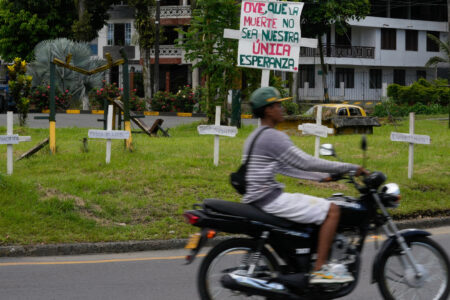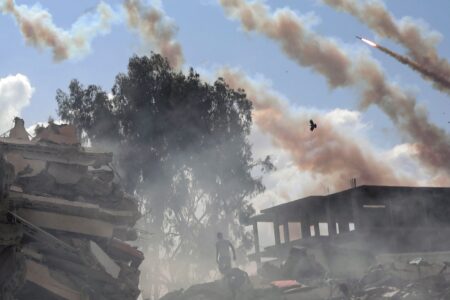
Even as I left my post in Sudan, my actions as whistleblower over Darfur were taking effect. Within days of my departure from Khartoum, the United Nations Security Council met for the first time ever to formally discuss the situation in Sudan. It issued its first-ever statement on Darfur, expressing “deep concern at the large-scale violations of human rights and international humanitarian law, including indiscriminate attacks on civilians, sexual violence, forced displacement and violence of an ethnic dimension,” and urged “that those responsible be held accountable for the atrocities taking place in Darfur.”
Further concrete action to halt the bloodshed followed shortly afterwards. The first peacekeepers — from the African Union — were on the ground within four months of my departure, tasked with re-establishing law and order and safeguarding Darfuri civilians. Notably, these were Rwandan soldiers — with the searing experience of their own country’s genocide to motivate their efforts in Darfur. Never before had the international community been forced to move so fast and so far from its original stance, which had been to do nothing. The world powers and the UN leadership that had poured such scorn on my desperate pleadings just a few weeks earlier had been forced to recant thanks to media pressure and the worldwide outrage that followed.
I continued to play a focal part in this. My role was to compile a detailed report presenting all the evidence we had gathered on the abuses in Darfur. That report prompted the UN to commission a formal inquiry into the allegations of war crimes in Darfur and who ultimately was responsible. Those files we had spirited out of Khartoum in a diplomatic bag provided crucial evidence that would help to identify those accused of war crimes.
The UN’s formal inquiry reported back to Kofi Annan that there was prima facie evidence of “crimes against humanity and war crimes including acts with genocidal intent” having occurred in Darfur. That forced the Security Council to refer the matter to the International Criminal Court in The Hague. The ICC started its investigations in June 2005 and went on to indict several members at the top of the Khartoum regime, including the Sudanese president himself, Omar Al Bashir. He was charged with five counts of crimes against humanity, two counts of war crimes and three counts of genocide. His charge sheet — the first ICC indictment of a serving head of state — reads like the plot of a horror movie: murder, extermination, torture, rape and more.
In short, a little over a year after I blew the whistle over Darfur, the three major factors that I had called for — UN Security Council resolutions on Darfur, peacekeepers to go in, those responsible to be referred to the ICC — had come to pass. At long last, the humanitarian relief operation also geared up, as donor governments rushed to fund life-saving food, water, shelter and healthcare. All of this came too late to halt the worst of the suffering in Darfur, because the killings had already happened and the Darfuri way of life been all but exterminated. But even peacekeepers late in the day are better than no peacekeepers at all. As to war-crimes indictments, although Al Bashir did all he could to make life more difficult for the international humanitarian organizations working in Darfur, it was never too late to see that justice was done.
I mention all this not in an effort to take any credit — I have no truck with self-aggrandizement in the face of one of the greatest failures of the world community in recent times. I do so simply to demonstrate a crucial point, perhaps even the central message of this book: one person’s actions can make a difference. It is possible to stand in the face of unconscionable evil, however high the stakes may be personally and however frightening it may be to do so. It is possible to stand alone; it is possible not to be one of those good men who choose to do nothing.
Death threats against me continued long after I left Khartoum, and indeed increased in severity. I ignored them, as I did my continuing critics in the UN system. Meanwhile, the stress and trauma of what I had endured in Sudan worked its course through my mind, body and spirit. My harsh self-judgment of what I saw as a personal failure added to my malaise. There was an inevitable personal toll in terms of my closest relationships.
As I struggled to adjust to my new life, what kept me going was a determination to see the architects of the final solution in Darfur brought to trial — including the Sudanese president, Omar Al Bashir. So, I remained one of the foremost voices speaking out over Darfur and agitating for justice.
It is possible to stand in the face of unconscionable evil, however high the stakes may be personally and however frightening it may be to do so.
After leaving my post as UN chief in Sudan, some kind of “disciplinary action” was mooted against me. However, I was still a [UK Department for International Development] employee seconded to the UN, and the British government defended me resolutely. DFID argued that if disciplinary action were to be considered by the UN, then the exact nature of my wrongdoing would need to be made crystal clear. In essence, the British government demanded to know why the UN wished to shoot the messenger. In the final analysis, no formal action was taken by the United Nations against me for my stand over Darfur.
Others were less fortunate — most notably those who had stood resolutely at my side. Isabelle, my special assistant — my support and confidante during the toughest times — paid a high price indeed. Although she returned initially to the UN in New York, and even received an award for her exceptional service to the organization, her days were numbered. One of her bosses warned her that as long as he remained in power she had no future there. Sudan was a sovereign country, he told her, and its government had the right to do as it willed. “Even when it comes to killing its own people?” she’d countered. He told her to keep quiet and to stop supporting me. Isabelle struggled on, writing powerful poems inspired by her experience in Sudan, but eventually she left New York and found work elsewhere.
As for me, after having taken the stance that I had I might have thought that I had left Darfur behind, but it never left me. It remained a raw and festering sore, and for no greater reason than that little had improved on the ground. Based in Geneva and working first for the World Health Organization (WHO) and then for the International Federation of the Red Cross and Red Crescent Societies (IFRC), I found myself continuing to follow events as they unfolded in Darfur with dismay. In spite of the peacekeepers going in, and despite the peace agreement between north and south Sudan, little had changed for the better for the Darfuri people.
More than two million Darfuris were displaced across Darfur and the rest of Sudan, or forced into refugee camps mostly in Chad. Few, if any, had been able to return to their devastated villages, because those areas remained horribly insecure. In spite of the peacekeepers, the security situation was abysmal: the Sudanese military continued to target Darfuri civilians, aid workers and even the peacekeepers themselves. While Khartoum had apparently bowed to the international community and allowed the peacekeepers in, in truth those soldiers wearing the distinctive UN blue beret were ill-equipped to keep the peace, and they were hampered and obstructed at every turn. Khartoum ensured they were unable to do their job, using force of arms where necessary.
Thus, Darfur had reached a situation of stalemate: the refugees remained in the camps, few could go home, and even in those camps they were prey to attacks by government forces and the dreaded Janjaweed. Women and children were raped when out collecting firewood. Men were murdered. Boys were abducted. So what in truth had changed? The level and scope of the violence was less, because the genocidaires had largely done their job, but, crucially, the violence was still of the same nature as before. Only its geographical focus had shifted — from the villages to the IDP [internally displaced persons] camps and the refugee camps in Chad.
I began to realize that in spite of all the international resolutions and condemnation, in spite of the peacekeepers going in on the ground, in spite of the war-crimes charges at The Hague, Darfur had actually become “the world’s most successful genocide” — to coin a chilling phrase that came to mind in one of my darkest moments in Geneva. In Rwanda, more people had died — some 800,000 — but at least the genocidaires were deposed from power, the killing stopped overnight and many of the key figures responsible put behind bars. Crucially, justice was seen to be done. There was a reckoning, reconciliation and Rwanda had made a start on the long road to recovery.
In Srebrenica, before Rwanda, NATO forces had driven the Serb genocidaires out, stopped the killing overnight, and the International Court for the Former Yugoslavia was formed to hold accountable the architects of the war crimes. Teams of elite soldiers flew snatch missions into remote areas, seizing suspected war criminals so they could be brought to trial. In Srebrenica and the wider Balkans, there had also been a reckoning and the hope of reconciliation with time.
Not one of those things had come to pass in Darfur. The chief architect of the genocide — Omar Al Bashir — remained president of Sudan; his key cohort — Ahmed Haroun, the operational commander on the ground — was promoted to high political office. The Janjaweed were still very much at large, their chief — Musa Hilal — growing ever more powerful. In short, not only had there been no reckoning but the architects of the final solution in Darfur had been rewarded financially, personally and politically for their heinous crimes. As for justice, reconciliation and — they remained a chimera.
This excerpt is taken from Against a Tide of Evil: How One Man Became the Whistleblower to the First Mass Murder of the Twenty-First Century (Neptune, NJ: Pegasus Books, 2013).
Photo: Diana Vucane / Shutterstock






